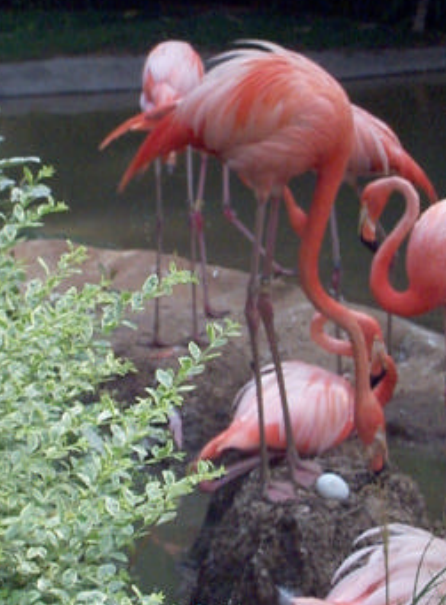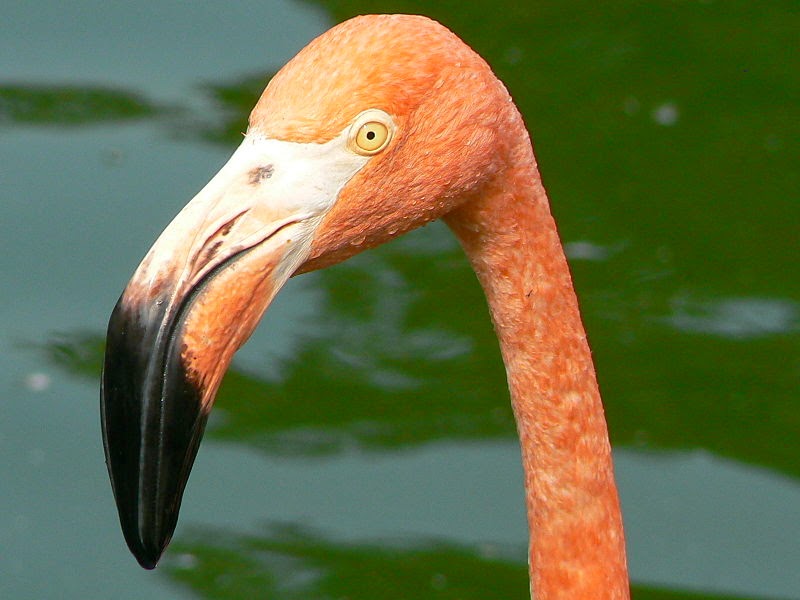Interesting Facts About Flamingos
Interesting Facts About Flamingos
1. Large pink bird with long legs and neck. Color can vary, with neck and wings more intense. Flight feathers are black, feet and legs grey and tip of pale bill is black.2. There are six different species of flamingos alive today. There are only four main breeding colonies of the American flamingo in the wild. One hundred years ago, there were close to fifty.
3. Although their feathers have been used in fashion over the years, the color fades after awhile. Loss of habitat, most specifically draining of lagoons and marshes, has had a disastrous effect on flamingo populations throughout the world.
4. Flamingos are highly gregarious and live in large, noisy flocks. There are a wide variety of vocalizations that include honks and barks.
5. They feed by day, wading through the water and stretching their necks down to eat.
6. They move their webbed feet in place to stir up small animals that are living in the mud below.
7. The flamingo holds its large, curved bill upside down in the water and uses its tongue to pump water in and out. Large comb-like ridges strain food particles from the water as they swish their heads from side to side.
8. Flight is labored and awkward for the flamingo, but they are able to fly up to 35 miles per hour. During flight, a flamingo’s neck and feet are stretched straight out.
9. The flamingo’s courtship usually begins in winter and can last for weeks or months.
10. Groups of a dozen to a hundred birds form a courting flock. There are many displays and courtship behaviors that are easily recognizable. Synchronized head-turning, marching and wing-stretching are all typical.
11. Both parents incubate the egg. For the first few weeks, the parents feed the chick a secretion from their digestive tract that is rich in carotenoid pigment. This is the same pigment that gives the adult birds their pink coloration. Since most of the pigment available goes to the chick, little is left to color the adults’ new feathers, leaving the parents a pale pink.
12. The chick’s bill is straight for about two weeks after hatching, then it begins to curve like the parents’ bills. Though fully grown at one year, they will not be fully pink for two or three years. At four years of age, the chick is fully mature and begins courting.
13. Flamingos have very tough skin on their legs which protects them from the chemical make-up of the extremely alkaline soda and salt lagoons!
14. Flamingos are an ancient group of birds. According to fossil evidence, they date back 10 million years!
15. The bill on a flamingo can be five inches long!
16. The Chilean flamingo lives up to 50 years in the wild. Its height can be up to 40 inches with a wingspan of 5 feet. It has long thin legs and a long flexible neck for dipping its curved bill into the water to filter food.
17. A flamingo uses its tongue to suck water through the comb like structures of its bill in order to filter food from the water.
18. Often stands on one leg by using a locking ankle joint, then tucks the other leg under its feathers to conserve heat, dry off for a while, or simply rest.
19. Tall legs allow it to wade in deeper water than most other birds.
20. Webbed feet are useful for swimming and wading in mud, also used to stir up food from the bottom of the wetland that is then filtered through the bill.
21. In the past, its tongue has been considered by humans a rare delicacy and its feathers have been sought for ornamentation.
22. Flamingo fossil records date back to the Miocene epoch, about 10 million years ago.
23. In many languages flamingo means red goose.
24. Flamingos have the longest legs in proportion to their bodies of all birds.
25. Wing tips have black pigment that provides structural strength.
26. Flamingos live naturally immense flocks of thousands of birds.
27. Flamingos can fly.
28. Andean flamingos are the only flamingos with yellow legs and feet.
29. Young flamingos are grey
30. Flamingos live up to 50 years
31. Flamingos of the Caribbean area have coral red feathers, and South American flamingos have pinkish white feathers.
32. What appears to be the flamingo's knee is actually its ankle.
33. The American flamingo has a boomerang shaped beak that can filter out water and trap food. Its beak is referred to as a "Roman nose."
34. Its method of feeding is similar to that of the baleen whales in that the food is taken in along with water and then the water is expelled through a comb-like structure (lamallae) leaving the food behind.
35. A flamingo's nest is made of mud, stones, straw and feathers and may be as high as 12 inches. A single egg is laid on the top of a tall mound that the female constructs.
36. Ancient Egyptian hieroglyphics used the flamingo to depict the color red.
37. In “Alice in Wonderland” the croquet mallets in the Queen’s Croquet Grounds are flamingos!
38. Only two groups of birds-flamingos and pigeons-feed their chicks on “milk” produced in the crops of both parent birds.
39. A group of flamingos is called a “stand.”





Comments
Post a Comment